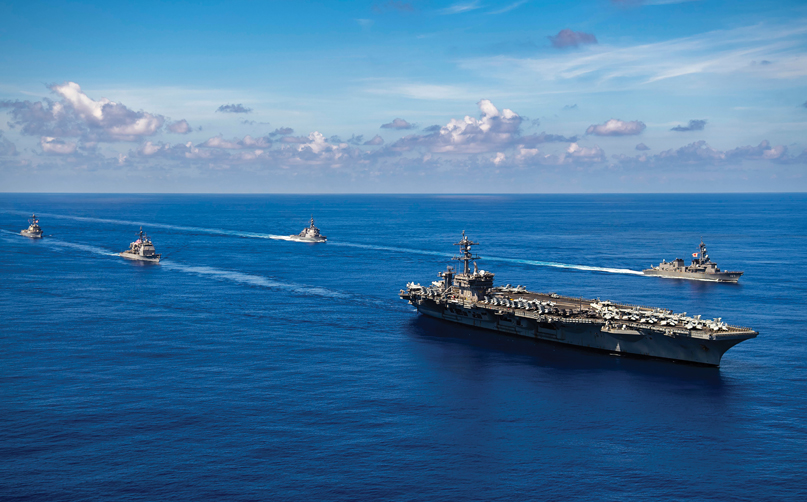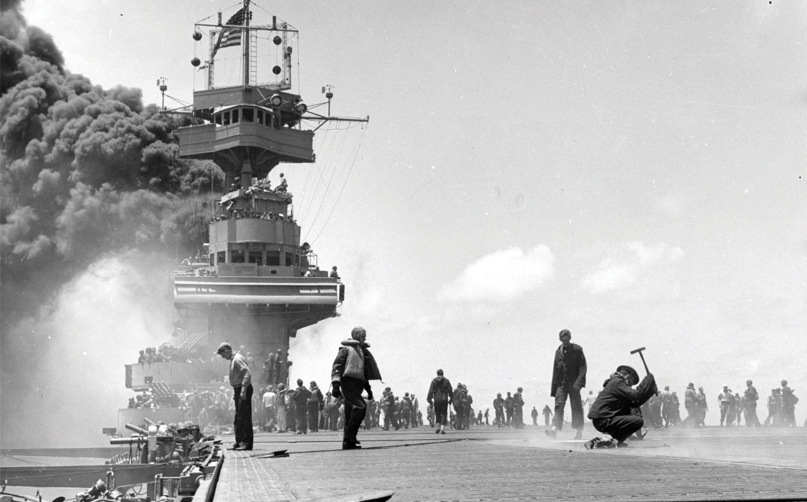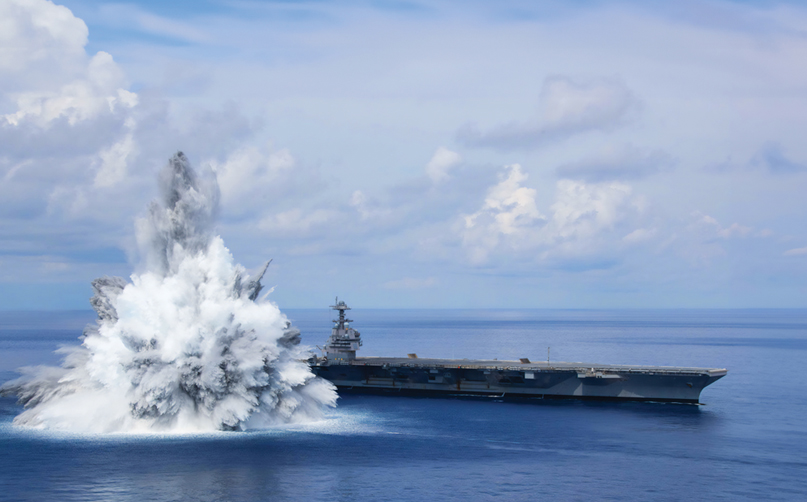Aircraft carriers possess a unique advantage in that they can host 75 or more aircraft that can accurately destroy hundreds of targets daily in a hostile state for weeks at a time while providing air cover for friendly naval and ground forces. Therefore, this weapon provides the United States with a qualitative advantage over its adversaries.
Each aircraft carrier is over 1,000 feet long and 25 stories high – equivalent to a 20-storey building. With nearly 5,000 sailors operating the ship and supporting the fighter jets. However, this qualitative superiority has begun losing its lustre with Russia and China having notably developed hypersonic missiles.
Concerns are rising in Washington that American aircraft carriers could be targeted by opposing powers, especially amid intensifying great power competition in the international system. Moreover, losing even one carrier would be a massive blow to the US, as well as its global prestige and influence.
Recently, multiple indicators have suggested that destroying an aircraft carrier may be feasible. However, military experts remain divided on the odds of this happening. This article will outline both perspectives and attempt to settle the ongoing debate.
Invincible Carriers
Various military experts believe a hostile state like China or Russia attempting to target an American carrier would face extreme difficulty, citing two key arguments:
1 The difficulty in destroying a carrier: Some military experts suggest that carriers are heavily armoured and may only be sunk using a tactical nuclear weapon. Carrier crews are also trained to overcome battle damage and keep the vessel in operation.
Moreover, carriers do not sail alone but with advanced air and missile defence ships like the Aegis system.
Proponents reference World War 2 experience, where America lost four major carriers in combat operations yet none lost over 10% of its crew with thousands being rescued in each case.
2 Prelude to Nuclear War: Some military analysts and political commentators rule out US adversaries targeting carriers since that would initiate a nuclear war between Washington and the attacking state.
However, deciding to launch a nuclear strike on a nuclear-armed state would be an immensely difficult decision. It should not be overlooked that a nuclear attack on a nuclear power essentially guarantees mutual annihilation through retaliatory strikes.

Escalating Technological Challenges
On the other hand, some opinions argue that Russian and Chinese hypersonic missiles pose serious threats to American carriers, as evidenced by the following indicators:
1 Expert Opinions: Former US Under Secretary of Defence for Research and Engineering, Michael Griffin, testified to Congress that the US lacks comparable hypersonic weapons that could reciprocally endanger China and Russia, along with defences against their systems.
Initial plans aim for Washington to develop hypersonic missile interceptors during 2025-2030.
However, these timelines may face delays. The US targeted 2023 to develop a hypersonic missile but a scheduled test was cancelled in late September 2023 – meaning it remains in experimental phases.
December 2023 reports cited the US Army stating the latest 5 Mach-capable hypersonic missile test failed due to a “mechanical engineering problem”. This indicates that Washington still lags behind Russia and China in producing such platforms which can now reach Mach 12.
2 Adversaries’ Capabilities: Long-standing concerns in Washington hold that carriers are more vulnerable to targeting amid the expanding capabilities of US opponents, who possess reconnaissance satellites, long-range cruise missiles, and advanced diesel-electric submarines.
However, hypersonic missiles are likely the most credible of these threats, especially with China and Russia recently sending repeated and consistent warnings about threatening American carriers.
One such warning came in a Chinese study published in May 2023 by the PLA-affiliated North University of China.
The study’s findings showed that a saturation attack with 24 supersonic anti-ship missiles could sink an entire carrier strike group led by the USS Gerald R Ford.
This represented the first publicised Chinese simulation of a successful hypersonic strike on an American carrier, utilising the DF-21 and DF-26 “carrier killer” ballistic missiles designed to target moving warships.
Undoubtedly, revealing this study amid heightened China-US tensions over Taiwan aimed to signal Beijing’s confidence in deterring any American defence of the island if China sought reunification militarily.
Russia has likewise indirectly threatened Washington – during the latest Israeli-Gaza war, the US deployed two carriers to the Eastern Mediterranean to deter Iran from regional escalation through its Lebanese Hezbollah proxy against Israel.
On October 11th, 2023, President Vladimir Putin criticised this move as destroying prospects for a peaceful Gaza solution, questioning if Washington sought to strike Lebanon or intimidate some party.
A week later, he announced Russian MiG-31K fighter jets armed with the Kinzhal hypersonic missile would begin patrolling neutral airspace over the Black Sea, clarifying that American carriers would be within strike range of Russian missiles.
However, Putin described this as a “reminder” rather than a threat to Washington that Russia would maintain “visual control and weapons control over what is happening in the Mediterranean Sea.” Moscow’s warning likely aimed to caution the US from targeting Syria, its regional ally, and confirm Western forces in the Eastern Mediterranean do not have unchecked dominance.
The Kinzhal’s efficacy has been proven, deployed by Russia to destroy an American Patriot air defence system in Ukraine on May 16, 2022, and a large Western arms depot newly supplied to Ukraine in the nation’s west on March 18, 2022.
The strikes affirmed the inadequacy of Western air defences in intercepting Russian hypersonic missiles and by extension their ability to threaten American carriers. Moreover, the Aegis system currently shielding US carriers is designed to counter slower, more predictable cruise missiles rather than hypersonic missiles which are faster and can make unexpected inflight changes
A French Figaro report likewise stated current leading American systems like Aegis, THAAD and Patriot would struggle to intercept hypersonic missiles except in the final radar-visible approach phases. Their interceptors are designed for slower, predictable trajectories, unlike hypersonic platforms. Therefore, these defence systems need upgrades that triple their current manoeuvrability before they can counter hypersonic missiles.
Separately, with Washington still failing to develop hypersonic missiles, how can it develop defences against them and perform live-fire tests that genuinely validate interceptors’ efficacy without actual hypersonic targets?
In contrast, Moscow affirms its nuclear-capable Zircon hypersonic missile fielded on Russian frigates can sink American carriers within “30 to 60 minutes” given its incredible 9 Mach speed rather than purely its explosive payload, which can weigh up to hundreds of kilogrammes.
While some Western analyses question the Zircon’s operational accuracy against moving targets like carriers, a British RUSI study concluded that although uncertainties remain around the missile’s combat effectiveness, it likely matches Russia’s official performance claims. More alarmingly, the report highlighted the prospect of submarine-based launches against carriers given the extreme quietness of Russia’s Yasen-class attack submarines that evade even British sonars. This means that Russia could use these submarines to launch the Zircon from underwater to bypass a carrier’s surrounding defences.

3 Drone Swarm Threat: Drone swarms may also threaten carriers, with Taiwanese reports suggesting Chinese development of carrier-attack suicide drone groups.
By exhausting a carrier battlegroup’s anti-air defences, drone swarms could open breach points to directly strike the carrier itself – although its extensive armour likely precludes catastrophic damage solely through drones. However, coordinated saturation attacks pairing hypersonic missiles with drone swarms mirror a similar tactic that successfully sank the Russian Moskva cruiser in April 2022.
Ukrainian forces used drones to distract the warship and overwhelm its defences, creating an opening for land-based Neptune missiles to achieve critical hits. At minimum two missiles penetrated the Moskva’s defences and detonated what was likely a missile rack’s exposed ordnance, critically damaging then sinking the cruiser.
4 Rescue Difficulties: Currently, the US is operating carriers with a far smaller number of escorts. For instance, the USS Nimitz’s South China Sea contingent comprised only three destroyers and one cruiser compared to two US carriers at 1942’s Battle of Santa Cruz having an escort of one battleship, six cruisers and twelve destroyers each.
More critically, modern escorts are also likely to maintain wider defensive spacing up to miles away from the carrier itself rather than closely shadowing as before – severely delaying assistance efforts. Furthermore, vital warships represent invaluable assets unto themselves whose commanders may refuse to commit to dangerous rescue efforts or firefighting that would diminish their fighting effectiveness.
Even success could generate casualties contaminated by the carrier’s possible radioactive leakage and this could lead to complete mission failure.
In conclusion, expert debate remains divided on whether modern carriers can withstand or evade concerted hypersonic missile attacks. Multiple concerning indicators support the credibility of this threat axis, especially given Western confirmation of successfully combat-proven Russian hypersonics following Ukraine deployment, contrasted against enduring American shortcomings in producing either hypersonic armaments or reliable interceptors. Yet the enormous escalation risks around potentially attacking a US carrier cannot be ignored either without clarity on prospective nuclear retaliation.
» By: Dr. Shadi Abdelwahab
(Military and strategic researcher)













